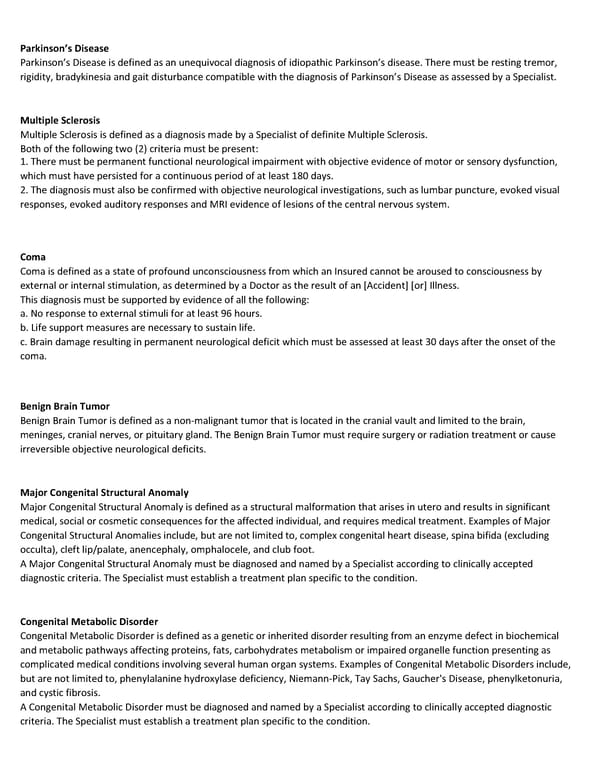Parkinson’s Disease Parkinson’s Disease is defined as an unequivocal diagnosis of idiopathic Parkinson’s disease. There must be resting tremor, rigidity, bradykinesia and gait disturbance compatible with the diagnosis of Parkinson’s Disease as assessed by a Specialist. Multiple Sclerosis Multiple Sclerosis is defined as a diagnosis made by a Specialist of definite Multiple Sclerosis. Both of the following two (2) criteria must be present: 1. There must be permanent functional neurological impairment with objective evidence of motor or sensory dysfunction, which must have persisted for a continuous period of at least 180 days. 2. The diagnosis must also be confirmed with objective neurological investigations, such as lumbar puncture, evoked visual responses, evoked auditory responses and MRI evidence of lesions of the central nervous system. Coma Coma is defined as a state of profound unconsciousness from which an Insured cannot be aroused to consciousness by external or internal stimulation, as determined by a Doctor as the result of an [Accident] [or] Illness. This diagnosis must be supported by evidence of all the following: a. No response to external stimuli for at least 96 hours. b. Life support measures are necessary to sustain life. c. Brain damage resulting in permanent neurological deficit which must be assessed at least 30 days after the onset of the coma. Benign Brain Tumor Benign Brain Tumor is defined as a non-malignant tumor that is located in the cranial vault and limited to the brain, meninges, cranial nerves, or pituitary gland. The Benign Brain Tumor must require surgery or radiation treatment or cause irreversible objective neurological deficits. Major Congenital Structural Anomaly Major Congenital Structural Anomaly is defined as a structural malformation that arises in utero and results in significant medical, social or cosmetic consequences for the affected individual, and requires medical treatment. Examples of Major Congenital Structural Anomalies include, but are not limited to, complex congenital heart disease, spina bifida (excluding occulta), cleft lip/palate, anencephaly, omphalocele, and club foot. A Major Congenital Structural Anomaly must be diagnosed and named by a Specialist according to clinically accepted diagnostic criteria. The Specialist must establish a treatment plan specific to the condition. Congenital Metabolic Disorder Congenital Metabolic Disorder is defined as a genetic or inherited disorder resulting from an enzyme defect in biochemical and metabolic pathways affecting proteins, fats, carbohydrates metabolism or impaired organelle function presenting as complicated medical conditions involving several human organ systems. Examples of Congenital Metabolic Disorders include, but are not limited to, phenylalanine hydroxylase deficiency, Niemann-Pick, Tay Sachs, Gaucher's Disease, phenylketonuria, and cystic fibrosis. A Congenital Metabolic Disorder must be diagnosed and named by a Specialist according to clinically accepted diagnostic criteria. The Specialist must establish a treatment plan specific to the condition.
 Critical Illness Benefits Summary Page 5 Page 7
Critical Illness Benefits Summary Page 5 Page 7